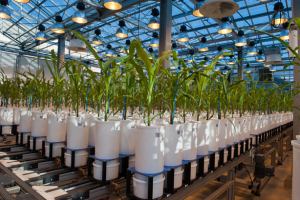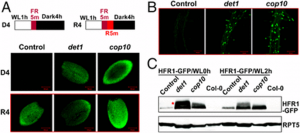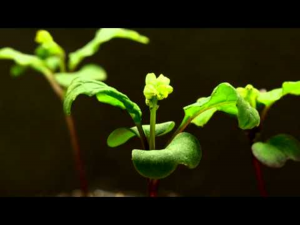Early planting of corn (Zea mays L.) is a strategy to avoid excessive heat and drought that often negatively influence grain production during its reproductive phase. An experiment was conducted by imposing very low (day/night, 21/13°C), low (25/17°C), and optimum (29/21°C) temperatures during seed germination and seedling growth stages under optimum moisture and nutrient conditions. Above- and belowground growth parameters were assessed at 18 d after seeding. Several root morphological traits were assessed using the WinRHIZO root image analysis system.
Proteins in the chloroplast thylakoid membrane system are derived from both the nuclear and plastid genomes. Mechanisms that localize nucleus-encoded proteins to the thylakoid membrane have been studied intensively, but little is known about the analogous issues for plastid-encoded proteins. This genome-wide, high-resolution analysis of the partitioning of chloroplast ribosomes between membrane and soluble fractions revealed that approximately half of the chloroplast-encoded thylakoid proteins integrate cotranslationally and half integrate posttranslationally.
Bovine tuberculosis is a chronic infectious disease that affects a broad range of mammalian hosts. It is a serious threat to agriculture in many less-developed countries. In this study, we introduced a mutation to the FokI of the right hand of wild-type transcription activator-like effector nuclease and established a transcription activator-like effector nickase system that creates single-strand breaks in the genome.
Presence/absence variants (PAVs) correlate closely to the phenotypic variation, by impacting plant genome sizes and the adaption to the environment. To shed more light on their genome-wide patterns, functions and the possibility of using them as molecular markers, we generated next generation genome sequencing data for four sorghum inbred lines and used associated bioinformatic pipelines to identify small-size PAVs (40–10 kb).
To identify genomic regions that carry genetic factors controlling embryogenic potential of isolated microspores of rapeseed, marker segregations were analysed in a segregating population of haploid microspore-derived embryos and a BC1 population from a cross between ‘Express 617’ and ‘RS239’.
Laboratório de Sistemática e Tafonomia de Vertebrados Fósseis, Departamento de Geologia e Paleontologia do Museu Nacional/UFRJ, Quinta da Boa Vista, s/n, São Cristóvão, 20940-040 Rio de Janeiro, RJ, Brasil. Health Sciences is one of the areas that the Annals of the Brazilian Academy of Sciences (AABC) will be stimulating. The purpose is to get scientists in Brazil and from abroad to submit manuscripts in a greater variety of fields than what we have been currently publishing.
Previous research using a bread wheat RIL population of the Seri/Babax cross showed that common QTL were associated with cooler canopies under both drought and heat-stressed conditions. A subset of RIL was grown under water-limited and hot-irrigated field environments to test how cooler canopies are related to root development. Eight sisters and the two parents were used in the study with genotypes grouped as COOL or HOT according to their respective QTL for canopy temperature and previous phenotypic data.
Meiotic recombination is known to vary over 1,000-fold in many eukaryotic organisms, including maize. This regional genomic variation has enormous consequences for plant breeders, who rely on meiotic cross-overs to fine-map quantitative traits and introgress favorable alleles. Deleterious mutations are also predicted to accumulate preferentially within low-recombination regions, particularly within historically outcrossing species, such as maize.
How organisms respond to environment changes is a fundamental and intriguing question in biology. Light is the energy resource and a crucial environmental cue for plant major developmental switches, such as seed germination. Studying the underlying mechanism is important for us to understand the basic principles of plant development and improve crop productions. Here we identify DET1 as a novel central repressor of seed germination. We further reveal that seeds use a multilevel regulatory circuit of triple feed-forward loops to sensitively and precisely mediate light-regulated germination.
Numerous studies using single nucleotide polymorphisms (SNPs) have been conducted in humans, and other animals, and in major crops, including rice, soybean, and Chinese cabbage. However, the number of SNP studies in cabbage is limited. In this present study, we evaluated whether 7,645 SNPs previously identified as molecular markers linked to disease resistance in the Brassica rapa genome could be applied to B. oleracea.


 Curently online :
Curently online :
 Total visitors :
Total visitors :









